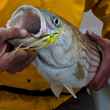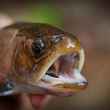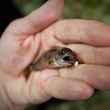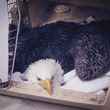It's small fly time on northeast tailwaters. On the Farmington River folks are fishing the trico hatch. A well tied imitation makes a #20 fly seem like a battleship and 6x look like an anchor chain. I like a brown thread body with a tuft of dun colored CDC and a #24 hook. It's one of the rare times I fish 7x. I'd fish 8x if I had any.
One of the nice things about tailwater hatches is that, despite all the variables that affect any natural process, they're pretty reliable. The hatches line up to fill the angling year. The fish seem as attuned as the anglers and I've spent many evenings fishing a single pattern. Once you're dialed in, you're set. Mostly.
Freestones, untethered to regular, temperate flows, can throw you more curves. Sure, they have the epic hatches that arrive like clockwork every year -- Hendricksons, March Browns, Alders, Cahills, White Flies, Isos -- but mixed in between and among are all manner of chaos. You can always count on some sort of caddis buzzing about, any number of small stones, midges, and BWOs. And, of course, the main events always overlap. It can make tying something on the tippet a total crapshoot.
Sunday evening, after taking smallmouth in fast water on a yellow bugger, I moved down to a popular pool just before dark to try and find rising fish. They were there. So were some bugs that were too small to see. Also Olives and midges and as it got closer to dark sporadic Isos and Cahills. The top of the pool and the faster water were full of anglers wading deep and hooking fish.
Wading wet I opted for some slower, shallower water. This summer has been cooler and wetter than normal. The water is plentiful, but less warm, and that combined with cool evening air temps made wet wading less comfortable than it would otherwise be. In front of me, where the current split around a huge boulder, were more fish than I could catch before the light failed.
To the left of the boulder three fish rose between the rock and the bank. Without being able to discern what they were taking I guessed at a small Olive emerger. The modest brown closest to the bank nudged it and then took it on the next cast. I was thankful to have dialed in the hatch so quickly. Olives.
I moved up a bit and cast to the midstream fish. He was sipping delicately and ignored my offering again and again. He even rose to something that was inches from my fly but nothing like my fly. With sporadic pale mayflies coming off I switched to a tiny pale parachute and soon had this fish to hand. A lucky guess but a good one. At least I now had the "right" fly on.
The third fish proceeded to ignore drift after drift of my pale offering. I repositioned myself to try a different presentation. Nothing. The light was failing, heck it had failed. In the dim light I chose a fly I could see tying on a #14 Usual. The brown hammered the Usual turning it into a soggy, slimed wad of rabbit fur.
I could have kept casting the Usual to rising trout but I knew I was kidding myself to think that I had anything figured out. It was an all-you-can-eat buffet night on this corner pool and the fish were sampling all the bounty the river had set before them.
There is something appealing to working a fish, decoding what's going on by applying intuition and experience, and bringing a finicky trout to hand. Of course, having a reliable fly on the end of the line eliminates the frustration of a third fly change in twenty minutes and the impossibility of finding the eye of a minute fly in dim light. Maybe the tricos are worth fishing after all. This year I’ll spring for 8x.
Steve lives and fishes in western Connecticut. When not working on his spey cast he writes at sippingemergers.com and on dead trees for various magazines.






























Comments